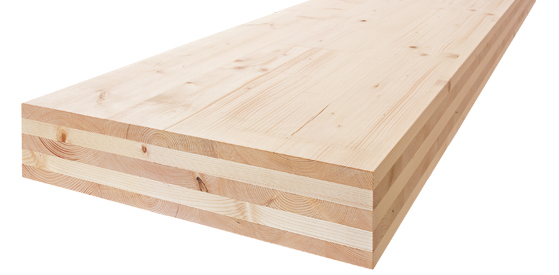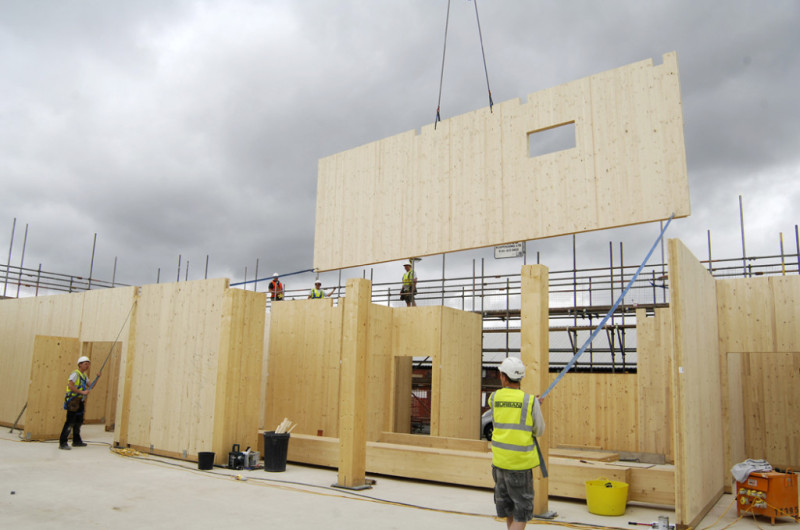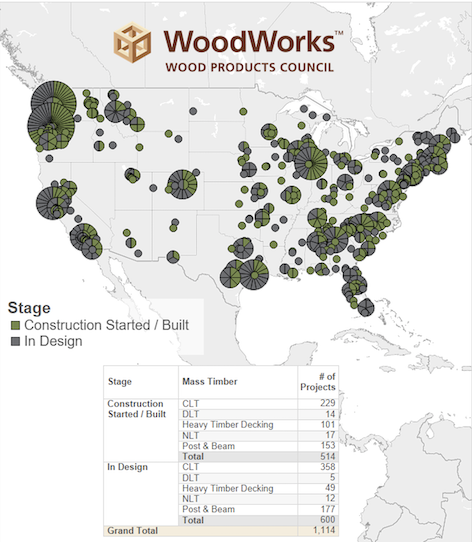What is Cross Laminated Timber (CLT)?
Cross Laminated Timber (CLT) is considered a Mass Timber product primarily because it is pre-fabricated. It is constructed by layering wood boards together - usually three, five, or seven side by side - alternating the direction of the boards 90 degrees between each layer (cross lamination). These layers, like most other engineered wood products, are attached together using structural adhesives [3]. A single layer of boards can range from 5/8 to 2 inches in thickness [2]. Large areas of CLT are manufactured, then cut to size further down the line. Because of its prefab construction and usage of conventional lumber boards, CLT construction is widely considered environmentally sustainable.
Figure 1: Example CLT panel (technologyinarchitecture.com).
How is CLT used?
CLT panels are solid, and therefore provide a high stiffness and transfer loads in all directions. Due to how it's constructed, panels can range from 2 up to 10 feet wide and can run up to lengths of 60 feet. The overall thickness of the panel can get up to 20 inches depending on the number of layers [2]. Because of all of these properties, CLT is commonly used today in the form of wall, floor, and roof panels, especially where long spans are needed. In Figure 2, you can see the outer layers of the panel shown run vertically, helping maximize its compressive resistance.
Figure 2: CLT panels used as structural wall elements in this all-wood construction structure (technologyinarchitecture.com).
Where did it come from?
CLT was actually derived in Europe, primarily in Germany and Austria in the early 1990s by an Austrian-born researcher named Gerhard Schickhofer [5]. In 2002 the first guidelines for CLT usage were published in Austria. It wasn't until the later 2000s where CLT was talked about in the United States. Fast forward to 2015, CLT is finally incorporated as a code-compliant building material identified in the National Design Specification (NDS) for wood construction in the United States.Current CLT Industry
While the CLT industry is minuscule relative to the entire scope of the construction industry, it stands alone and is growing rapidly. Last year in 2020, the CLT market in North America grossed $106 Million [4]. Since its inception in the US, its usage has expanded from just layered timber boards to more bespoke and composite solutions that incorporate steel or concrete into the structural element. Because CLT is carbon neutral -- much more than steel and concrete can say -- there is more than one advocacy group pushing the CLT and Mass Timber industry forward. With the addition of green incentives from the national and state levels of government, the CLT industry should see steady growth: an estimated $304.6 Million by 2026, boasting a compound annual growth rate of over 18% [4].The current landscape of Mass Timber/CLT Projects
According to WoodWorks, a wood products advocacy group, as of March 2021, 1,114 mass timber projects have been constructed or are being designed [1] Specifically, CLT makes up the majority of any single project type, as shown below:
Figure 3: Depiction of Mass Timber projects and their locale built/designed between 2013 and March 2021 (woodworks.org).
We can infer that this trend of CLT will only continue to grow, as it becomes more efficient to manufacture and more structural engineers take to the building material.References
- "Building Trends: Mass Timber.” WoodWorks, Mar. 2021, www.woodworks.org/publications-media/building-trends-mass-timber/.
- “Cross Laminated Timber Construction: CLT Panel.” Think Wood, 30 Mar. 2021, www.thinkwood.com/mass-timber/clt.
- “Cross-Laminated Timber (CLT).” APA, 2018, www.apawood.org/cross-laminated-timber.
- “North America Cross-Laminated Timber Market: Industry Trends, Share, Size, Growth, Opportunity and Forecast 2021-2026.” North America Cross-Laminated Timber (CLT) Market 2021-2026, www.imarcgroup.com/north-america-cross-laminated-timber-market
- Schickhofer, Gerhard (2013) [1994]. Starrer und nachgiebiger Verbund bei geschichteten, flächenhaften Holzstrukturen. Graz: Graz University of Technology. doi:10.3217/978-3-85125-262-0. ISBN 978-3-85125-268-2.


